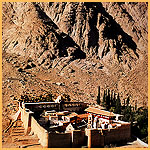|
Monasticism and the early monastic
centres
Monasticism originated in third-century Egypt,
where some Christians  chose
to pursue their faith removed from the world, either as hermits
in semi-desert areas, or in communities of the faithfull.
By the fourth century, both forms of monasticism were widespread.
Syria was famous for its solitary
ascetics, such
as the eccentric
Symeon the Stylite;
Asia Minor and Palestine, for their flourishing monastic communities
led respectively by
St Basil and
St Sabas. Dalmatou,
the first monastery in Constantinople, was founded in the
late fourth century. By 536, there were almost seventy monasteries
in the capital. By the sixth century, monastic life was governed
by fixed rules that controlled the daily and weekly routine,
prayer times and content, the monk's work, food, drink, and
clothing. The Justinianic legislation provided the legal basis
for bequeathing property to monasteries, which led to their
increasing prosperity. chose
to pursue their faith removed from the world, either as hermits
in semi-desert areas, or in communities of the faithfull.
By the fourth century, both forms of monasticism were widespread.
Syria was famous for its solitary
ascetics, such
as the eccentric
Symeon the Stylite;
Asia Minor and Palestine, for their flourishing monastic communities
led respectively by
St Basil and
St Sabas. Dalmatou,
the first monastery in Constantinople, was founded in the
late fourth century. By 536, there were almost seventy monasteries
in the capital. By the sixth century, monastic life was governed
by fixed rules that controlled the daily and weekly routine,
prayer times and content, the monk's work, food, drink, and
clothing. The Justinianic legislation provided the legal basis
for bequeathing property to monasteries, which led to their
increasing prosperity.
Monasteries generally began with a hermit, who withdrew
from the world and dwelt isolated in a cave or a hut. With
time, other monks joined him, creating a community. The founder
determined whether the place would be a
lavra, a loose
community of monks living separately but sharing Saturday
and Sunday prayers, or a
coenobium, an
enclosed monastery where monks met daily for prayers and meals.
A coenobium comprised a variety of buildings (such as churches
and chapels, cells for the monks, libraries, bathhouses, refectories,
kitchens, storerooms, water reservoirs, stables, hospices
and hospitals), the construction of which was funded by wealthy
admirers or with money bequeathed by the founder. Hospices
were usually built outside the monastery walls, and served
not only as a lodging for pilgrims and travellers but also
as a trading post for the monks' products. Monks kept worshops,
tended gardens and, in agricultural regions produced oil and
wine. The communal buildings of the coenobium were also those
of the lavra's nucleus, except that in the latter case they
were not surrounded by a wall. The monks of a lavra dwelt
in isolated caves or hermitages (cells or small complexes
including a chapel or a prayer corner).
|